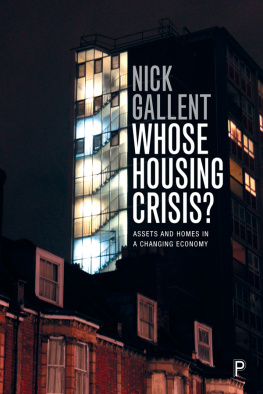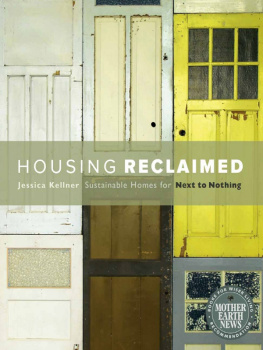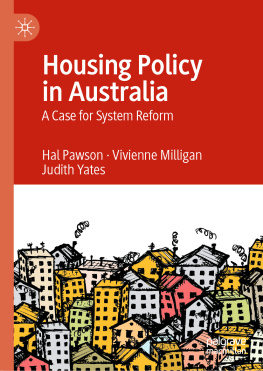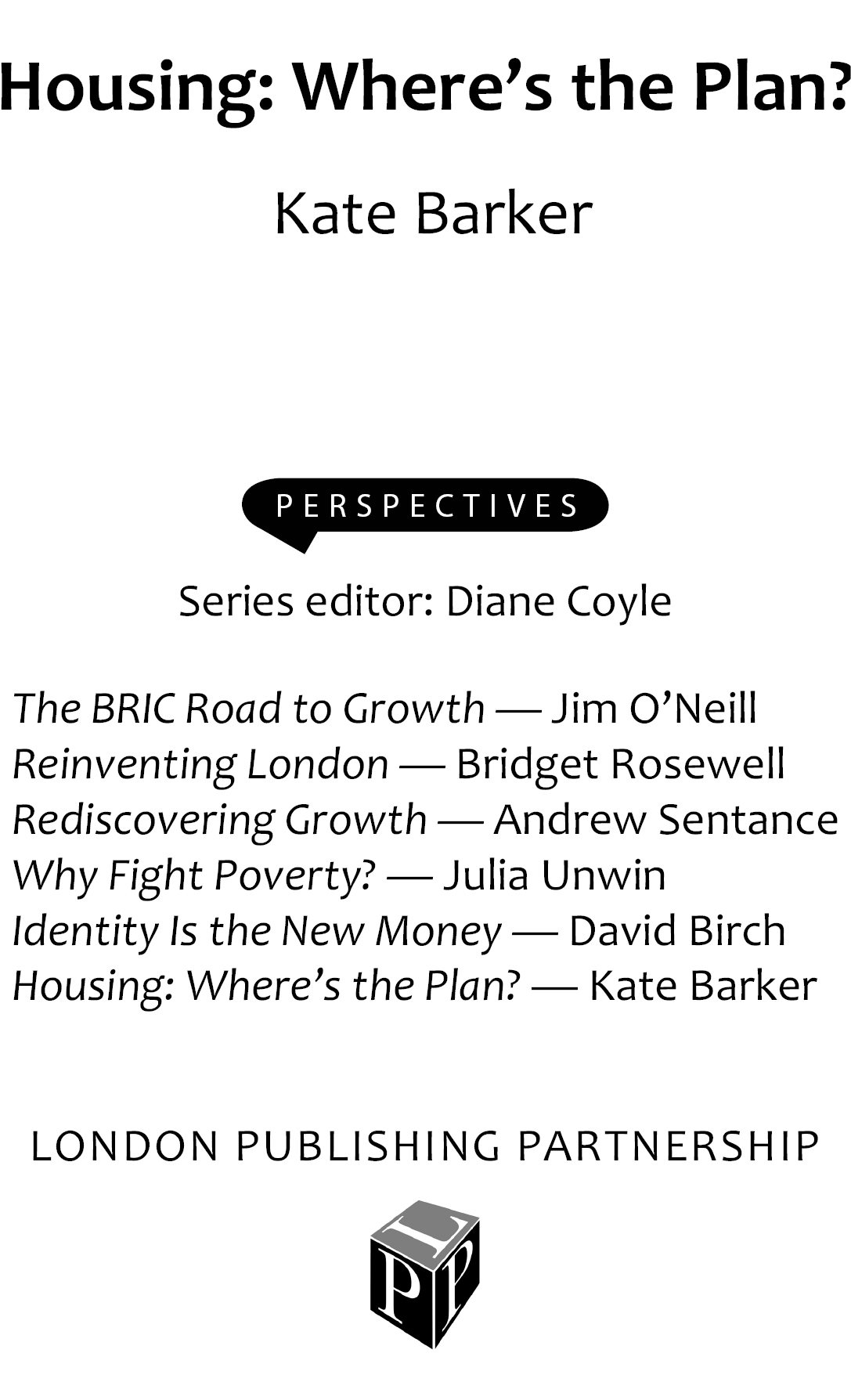Copyright 2014 Kate Barker
Published by London Publishing Partnership www.londonpublishingpartnership.co.uk
Published in association with Enlightenment Economics www.enlightenmenteconomics.com
All Rights Reserved
ISBN: 978-1-907994-40-1 (ebook)
A catalogue record for this book is available from the British Library
This book has been composed in Candara
Copy-edited and typeset by T&T Productions Ltd, London www.tandtproductions.com
Cover art by Kate Prentice
Preface
H ousing matters. We all need a home and we all want to live in a pleasant place. We talk about the housing market endlessly. But too few people really understand the underlying economics of the market and how housing interacts with finance, planning and taxation.
The last major review of UK housing supply, which I led, was published just over a decade ago. Its key contention that the UK (particularly England) needed to build homes at a faster rate was controversial at the time but has since become widely accepted. And yet the number of homes built in England from 2010 to 2013 was less than half the official estimate of how many more households would want to find somewhere to live. The signs are that 2014 will have seen increased homebuilding, but still far short of what is needed. Why is this, and shouldnt more be done to fix the housing market? Isnt the solution still building more housing in areas where people want to live?
The recent shortage of supply has exacerbated some underlying problems. England has a relatively old stock of housing some in poor condition and much of it in areas where the economy is now weaker, as economic activity is becoming increasingly concentrated in the South East. Empty homes are also often to be found in these less prosperous parts of the country. Yet local opposition and the failure of many local authorities to produce up-to-date plans for their area has led to a persistent undersupply of homes in much of southern England.
This means there is increasing inequality between those who are able to become homebuyers (often aided by parents who already have a stake in the housing market) and those who cannot afford to leave the private rented sector. Undersupply also contributes to volatility in house prices illustrated by the quick pick-up in prices in 2013 when it became easier to get a mortgage. In London the price rises were very rapid, though this was due in large part to rising demand from wealthy individuals from outside the UK.
The financial crisis was clearly the major factor behind this latest period of low supply. Housing demand was strongly suppressed as the recession took its toll on household incomes. In addition, UK banks cut back on their mortgage lending and, with belated caution, asked for larger deposits. House prices fell sharply in 20089 and were then relatively stable before starting to climb again during 2013.
Falling prices during the downturn hit housebuilders hard, as the land they had bought at pre-crisis prices suddenly became worth much less. With cash flow also hit as fewer homes were sold, many small and medium-sized builders went out of business. Several lean years have also weakened the skills and materials base for the industry, and it is likely to be some time before new supply returns to pre-crisis levels.
Even at the pre-crisis peak, the rate of new housing supply was not enough to meet demand pressures in England demand increases due to population growth and increasing incomes. If supply does not respond sufficiently to demand, then the outcome is obvious: prices rise and, what is worse, they are expected to continue rising. This means there is a big incentive for those who can afford it to invest in housing, while others get left further and further behind.
Housing affordability can be a misused term (indeed, I have misused it myself). It can be hard to get a mortgage due to the requirement for a large deposit and the new requirement to verify a reliable income. But once in home ownership, if the mortgage can be sustained, rising prices and favourable tax treatment mean that over the long term the costs of ownership can be quite low. It is often tenants, faced with rising rents, who really have an affordability problem.
In my housing supply review ten years ago, I pointed out that many people gain from an undersupply of housing: landowners and homeowners see the value of their assets rising, and local authorities gain from their ability to request that developers provide more infrastructure. But there are losers today: those who pay higher rents and are simply priced out of home ownership. And in the long run we all lose: there are economic costs as workers find it harder to move job around the country, the housing market is more volatile, we have a high level of household debt, which makes the economy harder to manage, and investment is diverted to too great an extent into the stock of bricks and mortar. But it is hard for people to perceive the underlying longer-term costs that are paid by everyone. Planning decisions therefore tend to give too much weight to the visible, local costs and too little to the wider and longer-term national benefits.
There are of course costs from building more homes. The most obvious is the loss of open space. This often accounts for much of the local resistance to development, alongside worries about the strain on infrastructure. But there are also very important issues concerning the balance of economic activity around England, water supply, biodiversity and other environmental pressures that require a response at a regional or national level. (At local level, it is often possible for a new development to be carried out in a manner that enhances some aspects of the environment.)
And the housing market is inherently difficult to manage. Inevitably, property is part of a households financial planning it is mainly a home but it is also an investment. We take on a lot of debt to finance house purchase, which makes families vulnerable if they face a shock that reduces their income. This also means that the government needs to be cautious about any housing-related tax changes in order to avoid major market disruption.
There have been positive policy developments, though, some of which began a decade ago with a stronger focus on local land supply for housing, and over time these policies will ameliorate housing-market problems. In particular, the National Planning Policy Framework has given real impetus to local authorities to put plans in place, and planning inspectors now have the ability to ensure that these plans provide for enough new homes. Following the financial crisis, the new Financial Policy Committee at the Bank of England has powers to curb potentially reckless lending, which should limit housing market volatility.
But there are some big concerns too. The government now has a long-term role in shared equity via the Help to Buy scheme. As one prominent commentator put it:
The government has increased its commitment to frighteningly expensive housing. It is a trap from which the UK may not now escape.
And the policy changes weve seen will not completely resolve the fundamentally intractable issues discussed in this book. It sets out the history of these problems and describes how the planning system, local democracy, the tax system and wealth distribution all set the framework and incentives that drive the behaviours of developers, landowners and households.










